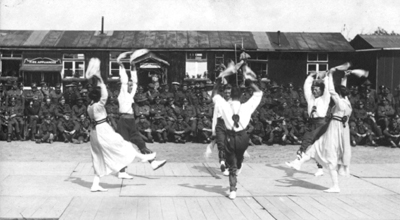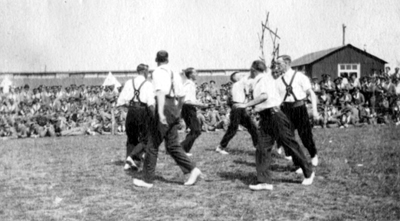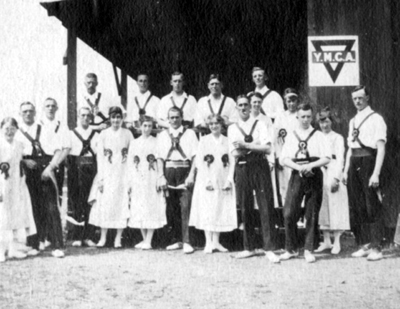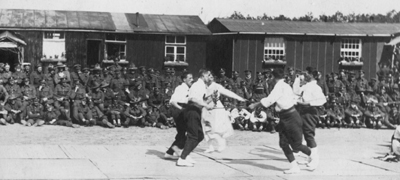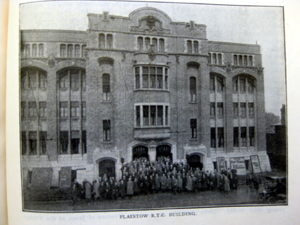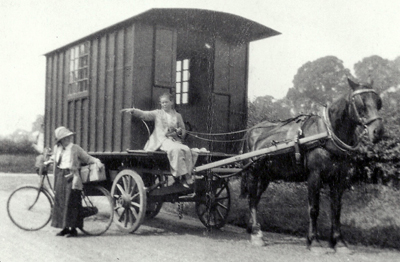There is no record of how long Maud Karpeles continued to work in Canning Town, but in 1915 she went to America with Cecil Sharp and remained there for most of the war years. Sharp — by now far too old to be accepted by the armed forces — had discovered that the rural communities living in the Appalachian mountains in North America had preserved many of the songs and dances that their Elizabethan ancestors had brought with them from Britain. He was anxious to write these down before they were forgotten with the impact of the modern world. Sharp, never a rich man, was also struggling to earn a living, and the fees that he earned from lecturing about folk dancing in America were very welcome. However, Sharp had had poor health throughout his life, including chronic asthma and intermittent but serious problems with his mobility and sight, so Maud’s assistance with both the collecting and the lecturing was critical, and became more so as he aged.
One of Elsie Oxenham’s characters explains that:
As a result of D.C. Daking’s actions during the First World War, folk dancing attained mass credibility. Daking became a sought-after teacher, and according to Elsie Oxenham in The Second Term at Rocklands (1930), she taught at parties and judged examinations and competitions throughout the country. When the Y.M.C.A. opened one of their ‘Red Triangle’ clubs in Greengate Street in Plaistow in 1921, in a purpose-built building costing more than £70,000, Daking became their first folk dance teacher. As Oxenham records, the club was dedicated to the soldiers who had been killed in the War, which must have made it particularly meaningful to Daking. It is possible that Daking worked in Plaistow at Maud Karpeles’s suggestion, particularly as the new Y.M.C.A. offered much better facilities than Mansfield House’s Barking Road premises. Certainly Oxenham records that Daking occasionally stayed overnight at the Settlement, and refers to Canning Town as one of the areas where Daking’s pupils came from. In another link with Maud’s earlier work in Canning Town, Oxenham records that ‘the Pixie’ organised groups of disabled children for one of the Abbey girls to take out for drives in the country, and it is probable that this too was based on fact. If Maud could no longer spare the time to teach in Canning Town, then Daking was the best teacher that the Society had to offer to replace her.*
D.C. Daking also worked in the West End during the day, making up dresses — folk dance teaching alone was not enough for women to support themselves on. In The New Abbey Girls (1924), Elsie Oxenham describes Daking’s rented flat in Holborn, which she shared with a typist and a WPC. Daking also owned a caravan in the country, where she welcomed friends at weekends; for a short period over the summer of 1914 she kept a diary about it, The Log of the Fine Companion. The caravan too makes an appearance in Queen of the Abbey Girls (1926). Unusually, Daking also wrote three books on psychology. Certainly Oxenham’s Abbey girls regarded Daking as being the source of enormous wisdom and understanding about people, and they consulted her whenever they had a difficult personal problem to resolve. Oxenham herself dedicated The Abbey Girls Again partly to “The Pixie, who gives us help and wise advice”. Sadly, Daking’s life came to an abrupt end when she committed suicide in 1942. She was working as a hostel manager at the time, having been refused permission to work with the troops again following the outbreak of the Second World War. No one knows her reasons, but it is entirely possible that Daking’s interest in psychology came from her personal experience of depression. All photographs are the property of the English Folk Dance and Song Society and should not be reproduced without their permission. Text © Ju Gosling aka ju90 2010
|




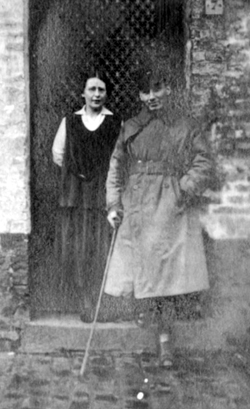 Back
in Europe, in 1916 four of Cecil Sharp’s six-man demonstration
folk dance team were killed at the Battle of the Somme: George Butterworth,
Perceval Lucas, R.J Tiddy and G.J. Wilkinson. Fortunately, although
Morris and Sword were traditionally male dance forms, Sharp had always
recognized the sense in women learning them, since there were many more
women teachers than there were men. Daisy Caroline Daking (1884-1942)
— Oxenham’s ‘Pixie’ —was one of these
teachers, and in 1917 she went out to France with the intention of teaching
the soldiers to dance when they were off-duty, thus making up 100-fold
for the loss of her male colleagues.
Back
in Europe, in 1916 four of Cecil Sharp’s six-man demonstration
folk dance team were killed at the Battle of the Somme: George Butterworth,
Perceval Lucas, R.J Tiddy and G.J. Wilkinson. Fortunately, although
Morris and Sword were traditionally male dance forms, Sharp had always
recognized the sense in women learning them, since there were many more
women teachers than there were men. Daisy Caroline Daking (1884-1942)
— Oxenham’s ‘Pixie’ —was one of these
teachers, and in 1917 she went out to France with the intention of teaching
the soldiers to dance when they were off-duty, thus making up 100-fold
for the loss of her male colleagues.